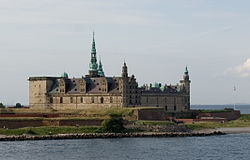Kronborg Castle
| Kronborg Castle | |
|---|---|
|
UNESCO world heritage |
|

|
|
| Kronborg Castle |
|
| National territory: |
|
| Type: | Culture |
| Criteria : | (iv) |
| Reference No .: | 696 |
| UNESCO region : | Europe and North America |
| History of enrollment | |
| Enrollment: | 2000 (session 24) |
Kronborg Castle ( Danish Kronborg Slot [ ˈkʀoːnbɔːʔʀ ]; German obsolete Kroneburg ) is a fortress in Helsingør on the Danish island of Zealand . Kronborg is located on a headland at the far northeast end of the island of Zealand. Only about four kilometers from the Swedish coast near Helsingborg , the fortress guards the entrance to the Øresund . The castle is also known as "Hamlet Castle " , as William Shakespeare set the plot of his play Hamlet here .
history
Erich von Pommern built the first fortress at this point under the name Krogen in 1420, but it only consisted of a square wall about 80 m long and guard houses in the corners. From 1429 it was used to collect the sound tariff from ships that wanted to cross the Øresund.
The Danish King Friedrich II had the medieval fortress expanded from 1574 to 1585 in the style of the Nordic Renaissance . The planning was carried out by the Flemish architect Hans van Paeschen , who, however, left the construction site three years later after disagreements with the king. On January 24, 1577, the name of the fortress was changed to Kronborg by royal decree ; from now on it was forbidden to use the old name. Although the construction work, now directed by Anton van Obberghen , lasted until 1585, Kronborg was officially inaugurated on April 15, 1582. The castle was now also the royal residence.
Due to the carelessness of two workers, Kronborg burned down almost completely in 1629, only the castle chapel was spared. Christian IV commissioned Hans van Steenwinckel with the restoration, which lasted until 1639. Except for a few details of the interior work and the missing tip of the southern tower, the original condition was restored. During the Second Northern War , Swedish troops under Carl Gustav Wrangel managed to capture the fortress in 1658 after three weeks of siege. Kronborg remained occupied until the Treaty of Copenhagen was signed in 1660. From 1688 to 1690, Kronborg was expanded and strengthened by the Danish master builder Lambert van Haven . The strongest fortress of this time was created by additional ramparts on the land side. Since 1785 Kronborg no longer serves as a royal residence, but only as a barracks and fortress. With the abolition of the sound tariff in 1847, mainly due to US urging , the fortress lost most of its military importance. In 1991 the Danish military finally left Kronborg. The gun salute from the ramparts is carried out by foreign units of the army .
From 1915 to 2012, part of the castle building housed the Danish Museum of Maritime Studies . The baroque palace itself was opened as a museum after renovations in 1935.
Since 30 November 2000 for Kronborg is part of the World Heritage of UNESCO .
Hamlet
The character Hamlet originally goes back to a Jutland prince who lived on the island of Mors . For his tragedy Hamlet, William Shakespeare moved the scene to Kronborg Castle in Helsingør (Elsinore). On the 200th anniversary of William Shakespeare's death in 1816, Hamlet was first played within the walls of Kronborg. Actors were soldiers from the Kronborg garrison. In the years that followed, there were frequent guest appearances by famous Hamlet actors in Kronborg, including Gustaf Gründgens in 1938 with Marianne Hoppe as Ophelia. In 2009 Jude Law was Hamlet, and in 2010 there was another German Hamlet performance by the Schaubühne am Lehniner Platz and Lars Eidinger as Hamlet. The Globe Theater performed Hamlet on Kronborg in 2011 .
Holger Danske
In the casemates under Kronborg Castle is one of Denmark's national symbols: Holger Danske .
The origin of this mythical figure goes back to the Ogier le Danois described in the Roland song . Holger Danske has been known in Scandinavia since 1510 , his story is popularized by Christiern Pedersen's Kong Holger Danskes Krønike from 1534 and later by Hans Christian Andersen's fairy tale Holger Danske (1845). Legend has it that this invincible warrior, homesick, returned from a campaign to Denmark and fell asleep there. Should the Danish kingdom be seriously threatened by an enemy, then Holger Danske will wake up again and go into battle.
In 1906, Hans Pedersen-Dan made a plaster model of Holger Danske for the Hotel Marienlyst in Helsingør. While the resulting bronze did not achieve particular popularity, the plaster model became the epitome of the mythical Holger Danske.
See also
literature
- Charles Christensen: Kronborg, Frederik II's Slot og dets videre Skæbne . Copenhagen 1950.
- David Hohnen: Hamlet's castle and Shakespeare's Elsinore . Copenhagen 2000. ISBN 87-7241-899-0
- Vibeke Woldbye, Lars Holst: Kronborg: the castle and the royal apartments . Copenhagen 2001. ISBN 87-987994-5-2
Web links
- Official website (English)
- Entry on the UNESCO World Heritage Center website ( English and French ).
Individual evidence
- ↑ Historical view from 1729: Ser. Reg. Caroli Gustavi Victoriosus e Sialandia discessus facta Pace Rothschildensi d. 5. Martij 1658 ( digitized version )
- ↑ [1]
Coordinates: 56 ° 2 ′ 20.5 ″ N , 12 ° 37 ′ 18.5 ″ E


